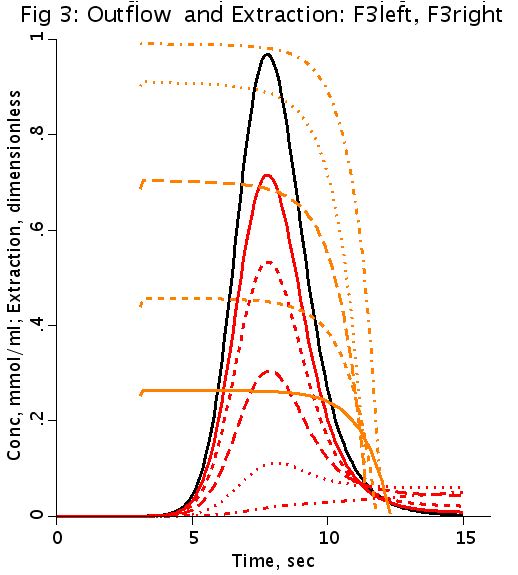Concurrent flow model for extraction during transcapilary passage. J.B. Bassingthwaighte: Circ Res 35:483-503, 1974.
Description

Figure 3: Increasing Permeability increases maximum Extraction.
Model consists of a BTEX20 for the permeant tracer, and a BTEX10 for the non-permeant tracer. Code from the Vacuscular operator model was included to model the venous transport function in Figure 8. ABSTRACT A model for capillary-tissue exchange in a uniformly perfused organ with uniform capillary transit times and no diffusional capillary interactions was designed to permit the exploration of the influences of various parameters on the interpretation of indicator-dilution curves obtained at the venous outflow following the simultaneous injection of tracers into the arterial inflow. These parameters include tissue geometric factors, longitudinal diffusion and volumes of distribution of tracers in blood and tissue, hematocrit, volumes of nonexchanging vessels and the sampling system, capillary permeability, P. capillary surface area, S, and flow of blood- or solute-containing fluid, F's. An assumption of instantaneous radial diffusion in the extravascular region is appropriate when intercapillary distances are small, as they are in the heart, or permeabilities are low, as they are for lipophobic solutes. Numerical solutions were obtained for dispersed input functions similar to normal intravascular dye-dilution curves. Axial extravascular diffusion showed a negligible influence at low permeabilities. The "instantaneous extraction" of a permeating solute can provide an estimate of PS/F's, the ratio of the capillary permeability-surface area product to the flow, when PS/F's lies between approximately 0.05 and 3.0; the limits of the range depend on the extravascular volume of distribution and the influences of intravascular dispersion. The most accurate estimates were obtained when experiments were designed so that PS/F's was between 0.2 and 1.0 or peak extractions were between 0.1 and 0.6.
Equations
The equations for this model may be viewed by running the JSim model applet and clicking on the Source tab at the bottom left of JSim's Run Time graphical user interface. The equations are written in JSim's Mathematical Modeling Language (MML). See the Introduction to MML and the MML Reference Manual. Additional documentation for MML can be found by using the search option at the Physiome home page.
- Download JSim model MML code (text):
- Download translated SBML version of model (if available):
- No SBML translation currently available.
- Information on SBML conversion in JSim
We welcome comments and feedback for this model. Please use the button below to send comments:
Bassingthwaighte JB. A concurrent flow model for extraction during transcapillary passage. Circ Res 35:483-503, 1974. Bassingthwaighte JB, Wang CY, and Chan IS. Blood-tissue exchange via transport and transformation by endothelial cells. Circ. Res. 65:997-1020, 1989. Goresky CA, Ziegler WH, and Bach GG. Capillary exchange modeling: Barrier-limited and flow-limited distribution. Circ Res 27: 739-764, 1970. Guller B, Yipintsoi T, Orvis AL, and Bassingthwaighte JB. Myocardial sodium extraction at varied coronary flows in the dog: Estimation of capillary permeability by residue and outflow detection. Circ Res 37: 359-378, 1975. King RB, Deussen A, Raymond GM, and Bassinthwaighte JB. A vascular transport operator. Am. J. Physiol. 265 (Heart Circ. Physiol. 34): H2196 -H2208, 1993. Page E and Bernstein RS. Cat heart muscle in vitro: V. Diffusion through a sheet of right ventricle. J. Gen Physiol 47:1129-1140, 1964. Poulain CA, Finlayson BA, and Bassingthwaighte JB. Efficient numerical methods for nonlinear-facilitated transport and exchange in a blood-tissue exchange unit, Ann Biomed Eng. 1997 May-Jun;25(3):547-64. Rose CP, Goresky CA, and Bach GG. The capillary and sarcolemmal barriers in the heart--an exploration of labeled water permeability. Circ Res 41: 515, 1977. Sangren WC and Sheppard CW. A mathematical derivation of the exchange of a labelled substance between a liquid flowing in a vessel and an external compartment. Bull Math BioPhys, 15, 387-394, 1953. Suenson M, Richmond DR, and JBassingthwaighte JB. Diffusion of sucrose, sodium, and water in ventricular myocardium. Am J Physiol 1974, 227(5): 1116-1123.
Please cite https://www.imagwiki.nibib.nih.gov/physiome in any publication for which this software is used and send one reprint to the address given below:
The National Simulation Resource, Director J. B. Bassingthwaighte, Department of Bioengineering, University of Washington, Seattle WA 98195-5061.
Model development and archiving support at https://www.imagwiki.nibib.nih.gov/physiome provided by the following grants: NIH U01HL122199 Analyzing the Cardiac Power Grid, 09/15/2015 - 05/31/2020, NIH/NIBIB BE08407 Software Integration, JSim and SBW 6/1/09-5/31/13; NIH/NHLBI T15 HL88516-01 Modeling for Heart, Lung and Blood: From Cell to Organ, 4/1/07-3/31/11; NSF BES-0506477 Adaptive Multi-Scale Model Simulation, 8/15/05-7/31/08; NIH/NHLBI R01 HL073598 Core 3: 3D Imaging and Computer Modeling of the Respiratory Tract, 9/1/04-8/31/09; as well as prior support from NIH/NCRR P41 RR01243 Simulation Resource in Circulatory Mass Transport and Exchange, 12/1/1980-11/30/01 and NIH/NIBIB R01 EB001973 JSim: A Simulation Analysis Platform, 3/1/02-2/28/07.

